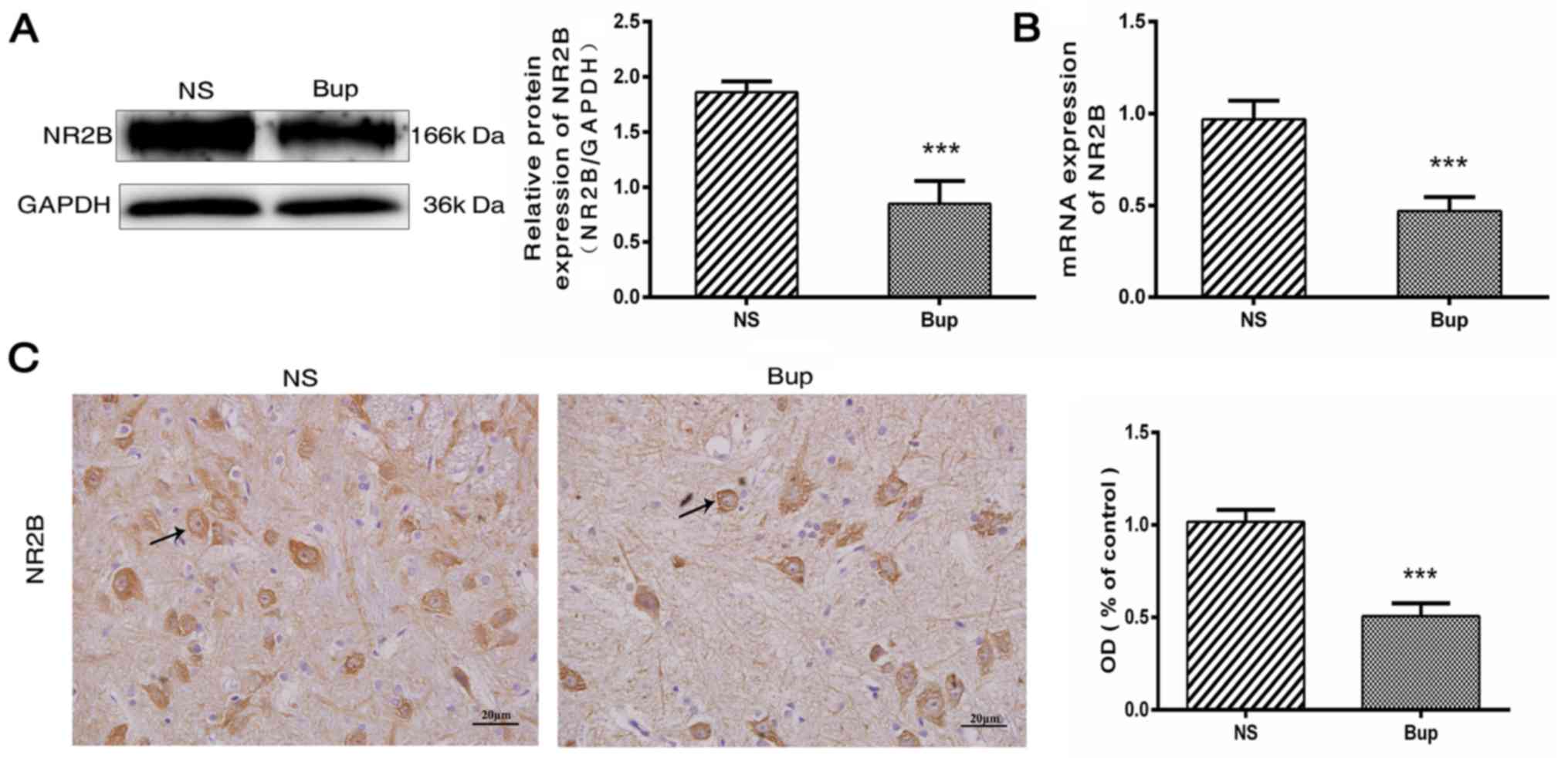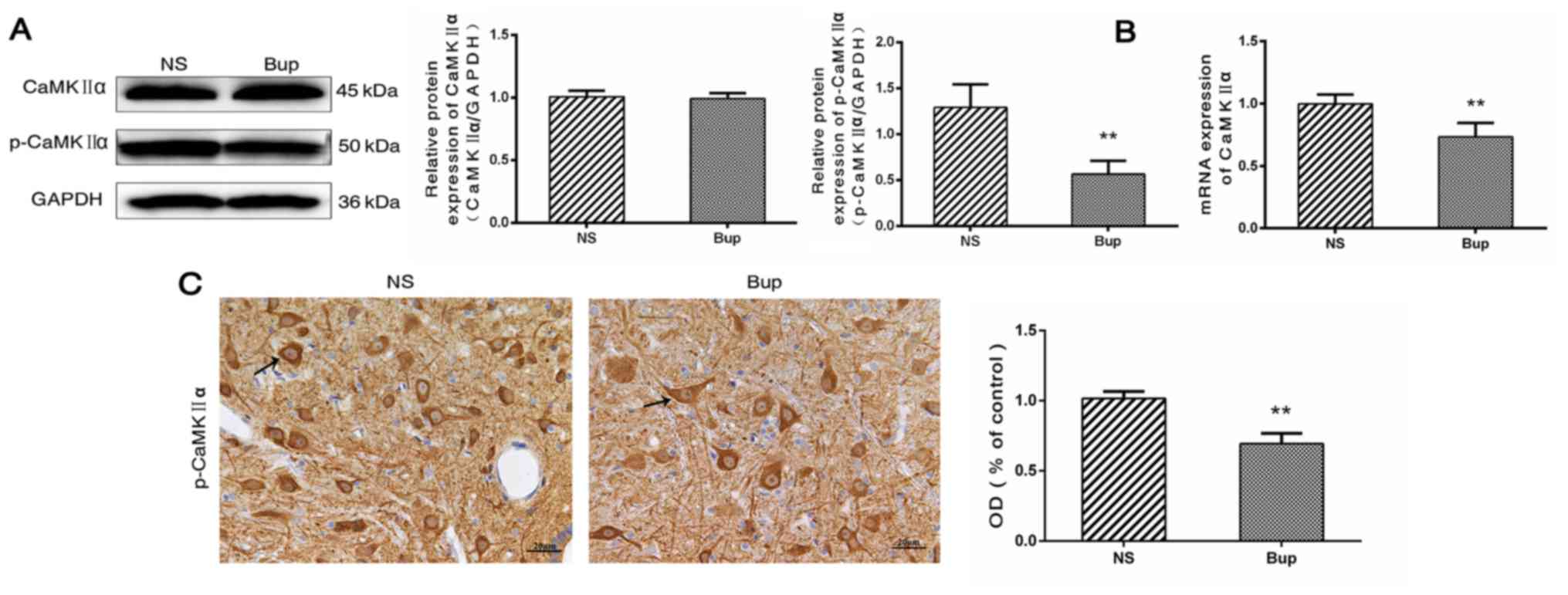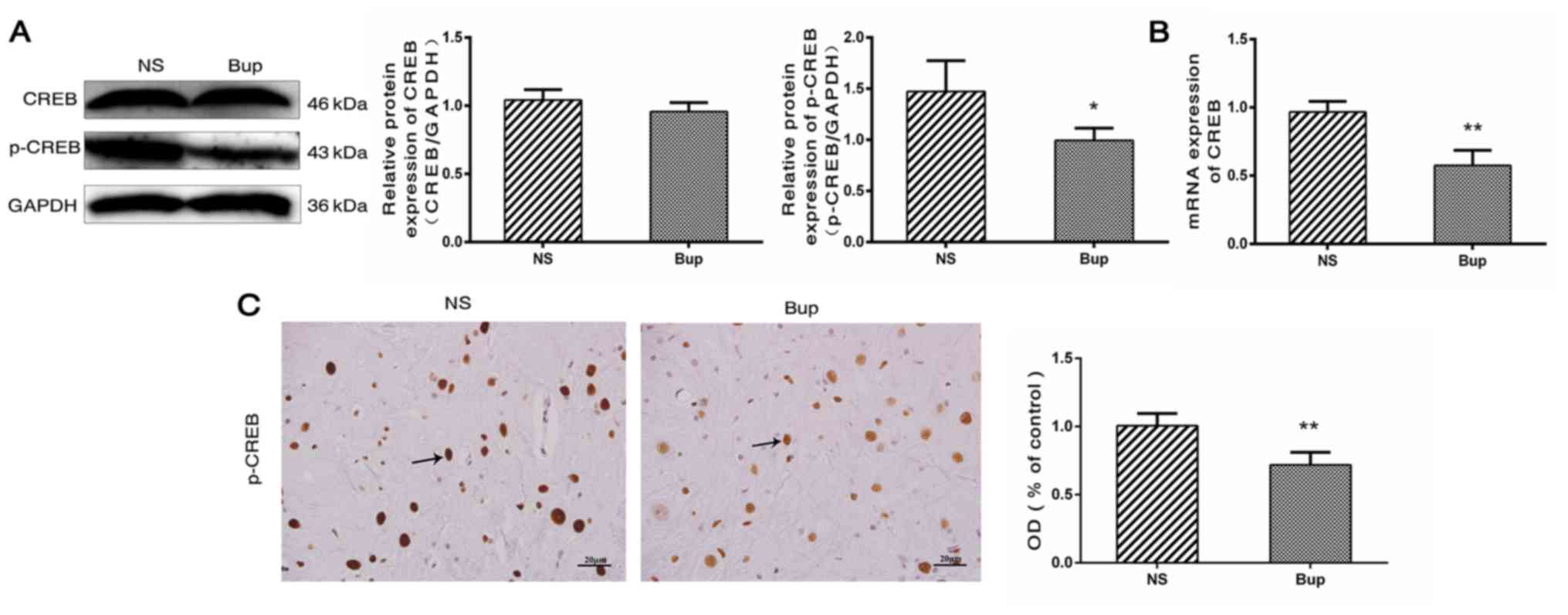|
1
|
Kim SH, Chun DH, Chang CH, Kim TW, Kim YM
and Shin YS: Effect of caudal block on sevoflurane requirement for
lower limb surgery in children with cerebral palsy. Paediatr
Anaesth. 21:394–398. 2011. View Article : Google Scholar : PubMed/NCBI
|
|
2
|
Xiang Y, Chen CQ, Chen HJ, Li M, Bao FP
and Zhu SM: The effect of epidural lidocaine administration on
sedation of propofol general anesthesia: A randomized trial. J Clin
Anesth. 26:523–529. 2014. View Article : Google Scholar : PubMed/NCBI
|
|
3
|
Zhang J, Zhang W and Li B: The effect of
epidural anesthesia with different concentrations of ropivacaine on
sevoflurane requirements. Anesth Analg. 104:984–986. 2007.
View Article : Google Scholar : PubMed/NCBI
|
|
4
|
Sentürk M, Gücyetmez B, Ozkan-Seyhan T,
Karadeniz M, Dinçer S, Akpir D, Sengül T and Denkel T: Comparison
of the effects of thoracic and lumbar epidural anaesthesia on
induction and maintenance doses of propofol during total i.v.
anaesthesia. Br J Anaesth. 101:255–260. 2008. View Article : Google Scholar : PubMed/NCBI
|
|
5
|
Gentili M, Huu PC, Enel D, Hollande J and
Bonnet F: Sedation depends on the level of sensory block induced by
spinal anaesthesia. Br J Anaesth. 81:970–971. 1998. View Article : Google Scholar : PubMed/NCBI
|
|
6
|
Pollock JE, Neal JM, Liu SS, Burkhead D
and Polissar N: Sedation during spinal anesthesia. Anesthesiology.
93:728–734. 2000. View Article : Google Scholar : PubMed/NCBI
|
|
7
|
Yang W, Geng Y, Liu Y, Li A, Liu J, Xing J
and Li W: Comparison of effects of thoracic epidural and
intravenous administration of lidocaine on target-controlled
infusion of propofol and tracheal intubation response during
induction of anesthesia. J Cardiothorac Vasc Anesth. 27:1295–1300.
2013. View Article : Google Scholar : PubMed/NCBI
|
|
8
|
Hodgson PS and Liu SS: Epidural lidocaine
decreases sevoflurane requirement for adequate depth of anesthesia
as measured by the Bispectral Index monitor. Anesthesiology.
94:799–803. 2001. View Article : Google Scholar : PubMed/NCBI
|
|
9
|
Doufas AG, Wadhwa A, Shah YM, Lin CM,
Haugh GS and Sessler DI: Block-dependent sedation during epidural
anaesthesia is associated with delayed brainstem conduction. Br J
Anaesth. 93:228–234. 2004. View Article : Google Scholar : PubMed/NCBI
|
|
10
|
Antognini JF, Atherley R and Carstens E:
Isoflurane action in spinal cord indirectly depresses cortical
activity associated with electrical stimulation of the reticular
formation. Anesth Analg. 96:999–1003. 2003.PubMed/NCBI
|
|
11
|
Lin TY, Chung CY, Lu CW, Huang SK, Shieh
JS and Wang SJ: Local anesthetics inhibit glutamate release from
rat cerebral cortex synaptosomes. Synapse. 67:568–579. 2013.
View Article : Google Scholar : PubMed/NCBI
|
|
12
|
Cherng CH, Wong CS, Wu CT and Yeh CC:
Glutamate release and neurologic impairment after intrathecal
administration of lidocaine and bupivacaine in the rat. Reg Anesth
Pain Med. 36:452–456. 2011. View Article : Google Scholar : PubMed/NCBI
|
|
13
|
Nishizawa N, Shirasaki T, Nakao S, Matsuda
H and Shingu K: The inhibition of the N-methyl-D-aspartate receptor
channel by local anesthetics in mouse CA1 pyramidal neurons. Anesth
Analg. 94:325–330. 2002. View Article : Google Scholar : PubMed/NCBI
|
|
14
|
Lanier WL, Iaizzo PA, Milde JH and
Sharbrough FW: The cerebral and systemic effects of movement in
response to a noxious stimulus in lightly anesthetized dogs.
Possible modulation of cerebral function by muscle afferents.
Anesthesiology. 80:392–401. 1994. View Article : Google Scholar : PubMed/NCBI
|
|
15
|
Zhai QZ and Traub RJ: The NMDA receptor
antagonist MK-801 attenuates c-Fos expression in the lumbosacral
spinal cord following repetitive noxious and non-noxious colorectal
distention. Pain. 83:321–329. 1999. View Article : Google Scholar : PubMed/NCBI
|
|
16
|
Tong CK and MacDermott AB: Synaptic GluN2A
and GluN2B containing NMDA receptors within the superficial dorsal
horn activated following primary afferent stimulation. J Neurosci.
34:10808–10820. 2014. View Article : Google Scholar : PubMed/NCBI
|
|
17
|
Saito Y, Kaneko M, Kirihara Y, Sakura S
and Kosaka Y: Interaction of intrathecally infused morphine and
lidocaine in rats (part I): Synergistic antinociceptive effects.
Anesthesiology. 89:1455–1463. 1998. View Article : Google Scholar : PubMed/NCBI
|
|
18
|
Oklinski MK, Lim JS, Choi HJ, Oklinska P,
Skowronski MT and Kwon TH: Immunolocalization of water channel
proteins AQP1 and AQP4 in rat spinal cord. J Histochem Cytochem.
62:598–611. 2014. View Article : Google Scholar : PubMed/NCBI
|
|
19
|
Wang HL, Li YX, Niu YT, Zheng J, Wu J, Shi
GJ, Ma L, Niu Y, Sun T and Yu JQ: Observing anti-inflammatory and
anti-nociceptive activities of glycyrrhizin through regulating
COX-2 and pro-inflammatory cytokines expressions in mice.
Inflammation. 38:2269–2278. 2015. View Article : Google Scholar : PubMed/NCBI
|
|
20
|
Livak KJ and Schmittgen TD: Analysis of
relative gene expression data using real-time quantitative PCR and
the 2−ΔΔCT method. Methods. 25:402–408. 2001. View Article : Google Scholar : PubMed/NCBI
|
|
21
|
Tverskoy M, Shagal M, Finger J and Kissin
I: Subarachnoid bupivacaine blockade decreases midazolam and
thiopental hypnotic requirements. J Clin Anesth. 6:487–490. 1994.
View Article : Google Scholar : PubMed/NCBI
|
|
22
|
Eappen S and Kissin I: Effect of
subarachnoid bupivacaine block on anesthetic requirements for
thiopental in rats. Anesthesiology. 88:1036–1042. 1998. View Article : Google Scholar : PubMed/NCBI
|
|
23
|
Agarwal A, Pandey R, Dhiraaj S, Singh PK,
Raza M, Pandey CK, Gupta D, Choudhury A and Singh U: The effect of
epidural bupivacaine on induction and maintenance doses of propofol
(evaluated by bispectral index) and maintenance doses of fentanyl
and vecuronium. Anesth Analg. 99:1684–1688. 2004. View Article : Google Scholar : PubMed/NCBI
|
|
24
|
Ingelmo PM, Ferri F and Fumagalli R:
Interactions between general and regional anesthesia. Minerva
Anestesiol. 72:437–445. 2006.PubMed/NCBI
|
|
25
|
Inagaki Y, Mashimo T, Kuzukawa A, Tsuda Y
and Yoshiya I: Epidural lidocaine delays arousal from isoflurane
anesthesia. Anesth Analg. 79:368–372. 1994. View Article : Google Scholar : PubMed/NCBI
|
|
26
|
Foffani G, Humanes-Valera D,
Calderon-Muñoz F, Oliviero A and Aguilar J: Spinal cord injury
immediately decreases anesthetic requirements in rats. Spinal Cord.
49:822–826. 2011. View Article : Google Scholar : PubMed/NCBI
|
|
27
|
Hodgson PS, Liu SS and Gras TW: Does
epidural anesthesia have general anesthetic effects? A prospective,
randomized, double-blind, placebo-controlled trial. Anesthesiology.
91:1687–1692. 1999. View Article : Google Scholar : PubMed/NCBI
|
|
28
|
Antognini JF and Carstens E: Isoflurane
blunts electroencephalographic and thalamic-reticular formation
responses to noxious stimulation in goats. Anesthesiology.
91:1770–1779. 1999. View Article : Google Scholar : PubMed/NCBI
|
|
29
|
Antognini JF, Carstens E, Sudo M and Sudo
S: Isoflurane depresses electroencephalographic and medial thalamic
responses to noxious stimulation via an indirect spinal action.
Anesth Analg. 91:1282–1288. 2000. View Article : Google Scholar : PubMed/NCBI
|
|
30
|
Aguilar J, Humanes-Valera D,
Alonso-Calviño E, Yague JG, Moxon KA, Oliviero A and Foffani G:
Spinal cord injury immediately changes the state of the brain. J
Neurosci. 30:7528–7537. 2010. View Article : Google Scholar : PubMed/NCBI
|
|
31
|
Alonso-Calviño E, Martinez-Camero I,
Fernández-López E, Humanes-Valera D, Foffani G and Aguilar J:
Increased responses in the somatosensory thalamus immediately after
spinal cord injury. Neurobiol Dis. 87:39–49. 2016. View Article : Google Scholar : PubMed/NCBI
|
|
32
|
Aanonsen LM and Wilcox GL: Nociceptive
action of excitatory amino acids in the mouse: Effects of spinally
administered opioids, phencyclidine and sigma agonists. J Pharmacol
Exp Ther. 243:9–19. 1987.PubMed/NCBI
|
|
33
|
Tang Q, Bangaru ML, Kostic S, Pan B, Wu
HE, Koopmeiners AS, Yu H, Fischer GJ, McCallum JB, Kwok WM, et al:
Ca2+-dependent regulation of Ca2+ currents in
rat primary afferent neurons: Role of CaMKII and the effect of
injury. J Neurosci. 32:11737–11749. 2012. View Article : Google Scholar : PubMed/NCBI
|
|
34
|
Zeitz KP, Giese KP, Silva AJ and Basbaum
AI: The contribution of autophosphorylated alpha-calcium-calmodulin
kinase II to injury-induced persistent pain. Neuroscience.
128:889–898. 2004. View Article : Google Scholar : PubMed/NCBI
|
|
35
|
Nakanishi M, Hata K, Nagayama T, Sakurai
T, Nishisho T, Wakabayashi H, Hiraga T, Ebisu S and Yoneda T: Acid
activation of Trpv1 leads to an up-regulation of calcitonin
gene-related peptide expression in dorsal root ganglion neurons via
the CaMK-CREB cascade: A potential mechanism of inflammatory pain.
Mol Biol Cell. 21:2568–2577. 2010. View Article : Google Scholar : PubMed/NCBI
|
|
36
|
Descalzi G, Fukushima H, Suzuki A, Kida S
and Zhuo M: Genetic enhancement of neuropathic and inflammatory
pain by forebrain upregulation of CREB-mediated transcription. Mol
Pain. 8:902012. View Article : Google Scholar : PubMed/NCBI
|
|
37
|
Miletic G, Pankratz MT and Miletic V:
Increases in the phosphorylation of cyclic AMP response element
binding protein (CREB) and decreases in the content of calcineurin
accompany thermal hyperalgesia following chronic constriction
injury in rats. Pain. 99:493–500. 2002. View Article : Google Scholar : PubMed/NCBI
|
|
38
|
Ma W, Hatzis C and Eisenach JC:
Intrathecal injection of cAMP response element binding protein
(CREB) antisense oligonucleotide attenuates tactile allodynia
caused by partial sciatic nerve ligation. Brain Res. 988:97–104.
2003. View Article : Google Scholar : PubMed/NCBI
|
|
39
|
Katano T, Nakazawa T, Nakatsuka T,
Watanabe M, Yamamoto T and Ito S: Involvement of spinal
phosphorylation cascade of Tyr1472-NR2B, Thr286-CaMKII, and
Ser831-GluR1 in neuropathic pain. Neuropharmacology. 60:609–616.
2011. View Article : Google Scholar : PubMed/NCBI
|
|
40
|
Wang Z, Ma W, Chabot JG and Quirion R:
Calcitonin gene-related peptide as a regulator of neuronal
CaMKII-CREB, microglial p38-NFκB and astroglial ERK-Stat1/3
cascades mediating the development of tolerance to morphine-induced
analgesia. Pain. 151:194–205. 2010. View Article : Google Scholar : PubMed/NCBI
|
|
41
|
Wang Y, Wu J, Lin Q, Nauta HJ, Yue Y and
Fang L: Effects of general anesthetics on visceral pain
transmission in the spinal cord. Mol Pain. 4:502008. View Article : Google Scholar : PubMed/NCBI
|
|
42
|
Pan X, Chen J, Wang W, Chen L, Wang L, Ma
Q, Zhang J, Chen L, Wang G, Zhang M, et al: Resveratrol-induced
antinociception is involved in calcium channels and
calcium/caffeine-sensitive pools. Oncotarget. 8:9399–9409.
2017.PubMed/NCBI
|
|
43
|
Miranda A, Mickle A, Bruckert M,
Kannampalli P, Banerjee B and Sengupta JN: NMDA receptor mediates
chronic visceral pain induced by neonatal noxious somatic
stimulation. Eur J Pharmacol. 744:28–35. 2014. View Article : Google Scholar : PubMed/NCBI
|
|
44
|
Crown ED, Gwak YS, Ye Z, Yu Tan H, Johnson
KM, Xu GY, McAdoo DJ and Hulsebosch CE: Calcium/calmodulin
dependent kinase II contributes to persistent central neuropathic
pain following spinal cord injury. Pain. 153:710–721. 2012.
View Article : Google Scholar : PubMed/NCBI
|
|
45
|
Fang L, Wu J, Zhang X, Lin Q and Willis
WD: Calcium/calmodulin dependent protein kinase II regulates the
phosphorylation of cyclic AMP-responsive element-binding protein of
spinal cord in rats following noxious stimulation. Neurosci Lett.
374:1–4. 2005. View Article : Google Scholar : PubMed/NCBI
|
|
46
|
Mitsikostas DD, Knight YE, Lasalandra M,
Kavantzas N and Goadsby PJ: Triptans attenuate capsaicin-induced
CREB phosphorylation within the trigeminal nucleus caudalis: A
mechanism to prevent central sensitization? J Headache Pain.
12:411–417. 2011. View Article : Google Scholar : PubMed/NCBI
|
|
47
|
Liu H, Zhang Y, Qi D and Li W:
Downregulation of the spinal NMDA receptor NR2B subunit during
electro-acupuncture relief of chronic visceral hyperalgesia. J
Physiol Sci. 67:197–206. 2017. View Article : Google Scholar : PubMed/NCBI
|
|
48
|
Paganelli MA and Popescu GK: Actions of
bupivacaine, a widely used local anesthetic, on NMDA receptor
responses. J Neurosci. 35:831–842. 2015. View Article : Google Scholar : PubMed/NCBI
|
|
49
|
Furutani K, Ikoma M, Ishii H, Baba H and
Kohno T: Bupivacaine inhibits glutamatergic transmission in spinal
dorsal horn neurons. Anesthesiology. 112:138–143. 2010. View Article : Google Scholar : PubMed/NCBI
|
|
50
|
de Sousa Abreu R, Penalva LO, Marcotte EM
and Vogel C: Global signatures of protein and mRNA expression
levels. Mol Biosyst. 5:1512–1526. 2009.PubMed/NCBI
|
|
51
|
Fraser HB, Hirsh AE, Giaever G, Kumm J and
Eisen MB: Noise minimization in eukaryotic gene expression. PLoS
Biol. 2:e1372004. View Article : Google Scholar : PubMed/NCBI
|

















